Irene Amerini
Shedding Light on Depth: Explainability Assessment in Monocular Depth Estimation
Sep 19, 2025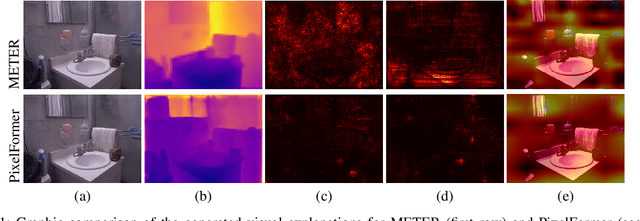
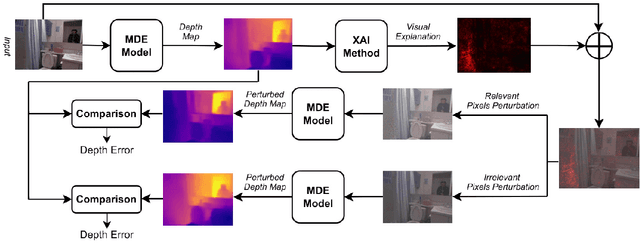
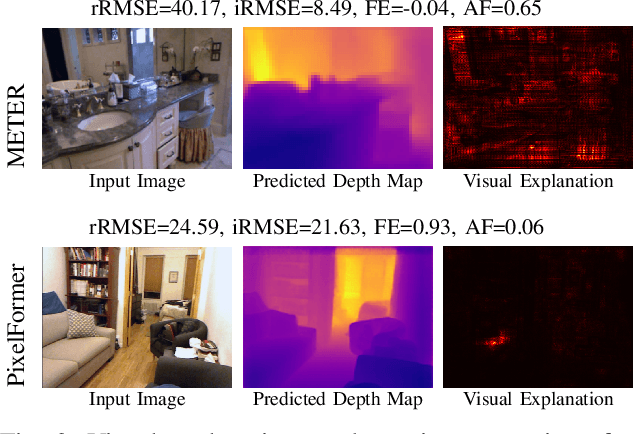
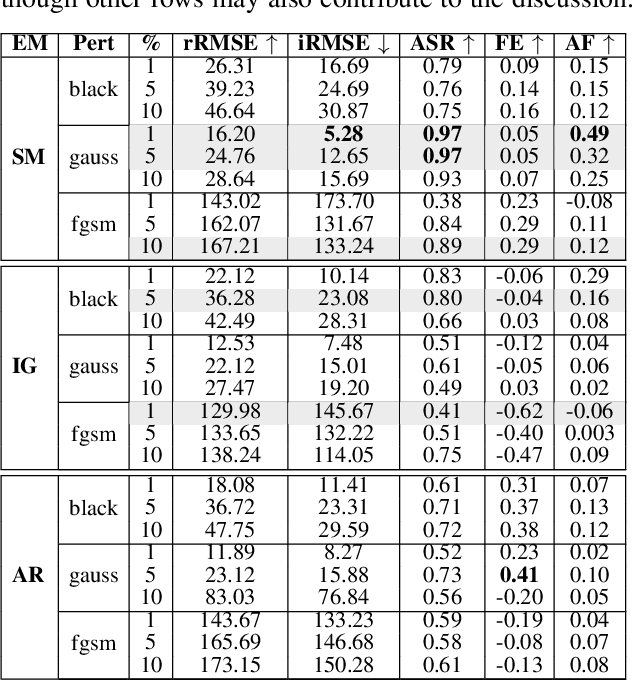
Abstract:Explainable artificial intelligence is increasingly employed to understand the decision-making process of deep learning models and create trustworthiness in their adoption. However, the explainability of Monocular Depth Estimation (MDE) remains largely unexplored despite its wide deployment in real-world applications. In this work, we study how to analyze MDE networks to map the input image to the predicted depth map. More in detail, we investigate well-established feature attribution methods, Saliency Maps, Integrated Gradients, and Attention Rollout on different computationally complex models for MDE: METER, a lightweight network, and PixelFormer, a deep network. We assess the quality of the generated visual explanations by selectively perturbing the most relevant and irrelevant pixels, as identified by the explainability methods, and analyzing the impact of these perturbations on the model's output. Moreover, since existing evaluation metrics can have some limitations in measuring the validity of visual explanations for MDE, we additionally introduce the Attribution Fidelity. This metric evaluates the reliability of the feature attribution by assessing their consistency with the predicted depth map. Experimental results demonstrate that Saliency Maps and Integrated Gradients have good performance in highlighting the most important input features for MDE lightweight and deep models, respectively. Furthermore, we show that Attribution Fidelity effectively identifies whether an explainability method fails to produce reliable visual maps, even in scenarios where conventional metrics might suggest satisfactory results.
WILD: a new in-the-Wild Image Linkage Dataset for synthetic image attribution
Apr 29, 2025Abstract:Synthetic image source attribution is an open challenge, with an increasing number of image generators being released yearly. The complexity and the sheer number of available generative techniques, as well as the scarcity of high-quality open source datasets of diverse nature for this task, make training and benchmarking synthetic image source attribution models very challenging. WILD is a new in-the-Wild Image Linkage Dataset designed to provide a powerful training and benchmarking tool for synthetic image attribution models. The dataset is built out of a closed set of 10 popular commercial generators, which constitutes the training base of attribution models, and an open set of 10 additional generators, simulating a real-world in-the-wild scenario. Each generator is represented by 1,000 images, for a total of 10,000 images in the closed set and 10,000 images in the open set. Half of the images are post-processed with a wide range of operators. WILD allows benchmarking attribution models in a wide range of tasks, including closed and open set identification and verification, and robust attribution with respect to post-processing and adversarial attacks. Models trained on WILD are expected to benefit from the challenging scenario represented by the dataset itself. Moreover, an assessment of seven baseline methodologies on closed and open set attribution is presented, including robustness tests with respect to post-processing.
Z-SASLM: Zero-Shot Style-Aligned SLI Blending Latent Manipulation
Mar 29, 2025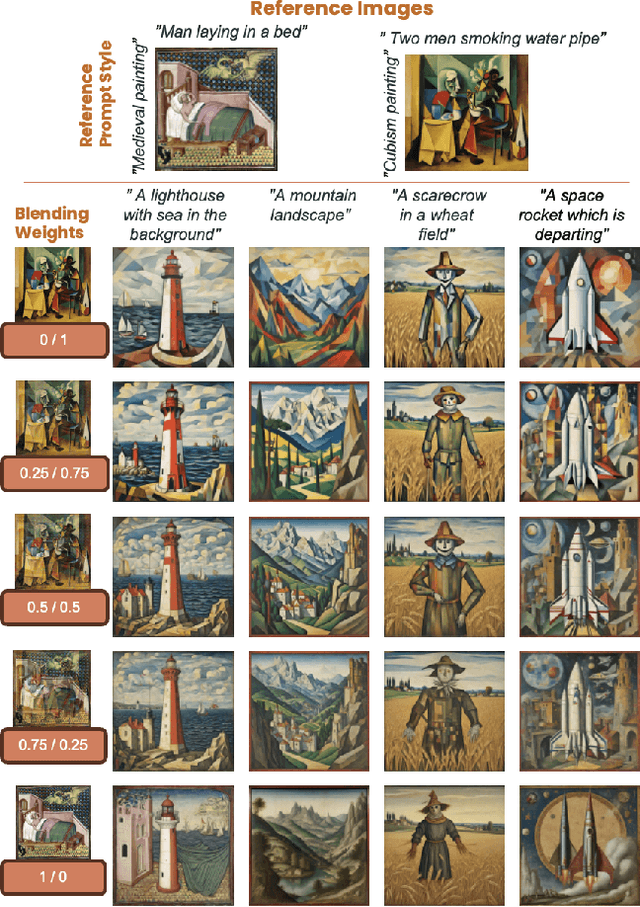
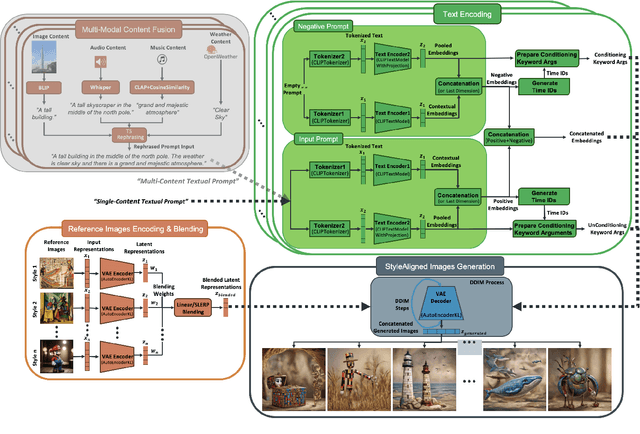

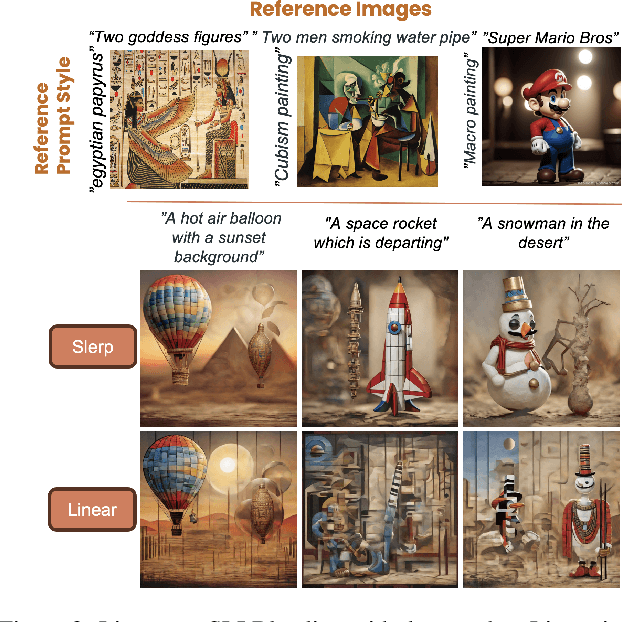
Abstract:We introduce Z-SASLM, a Zero-Shot Style-Aligned SLI (Spherical Linear Interpolation) Blending Latent Manipulation pipeline that overcomes the limitations of current multi-style blending methods. Conventional approaches rely on linear blending, assuming a flat latent space leading to suboptimal results when integrating multiple reference styles. In contrast, our framework leverages the non-linear geometry of the latent space by using SLI Blending to combine weighted style representations. By interpolating along the geodesic on the hypersphere, Z-SASLM preserves the intrinsic structure of the latent space, ensuring high-fidelity and coherent blending of diverse styles - all without the need for fine-tuning. We further propose a new metric, Weighted Multi-Style DINO ViT-B/8, designed to quantitatively evaluate the consistency of the blended styles. While our primary focus is on the theoretical and practical advantages of SLI Blending for style manipulation, we also demonstrate its effectiveness in a multi-modal content fusion setting through comprehensive experimental studies. Experimental results show that Z-SASLM achieves enhanced and robust style alignment. The implementation code can be found at: https://github.com/alessioborgi/Z-SASLM.
Enhancing Ground-to-Aerial Image Matching for Visual Misinformation Detection Using Semantic Segmentation
Feb 10, 2025

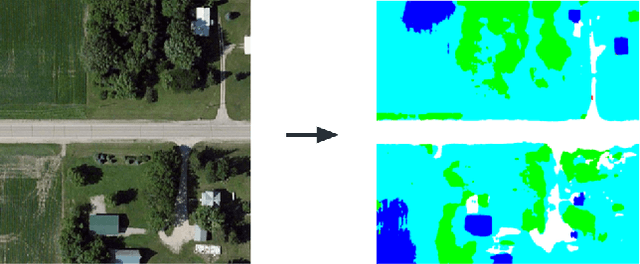

Abstract:The recent advancements in generative AI techniques, which have significantly increased the online dissemination of altered images and videos, have raised serious concerns about the credibility of digital media available on the Internet and distributed through information channels and social networks. This issue particularly affects domains that rely heavily on trustworthy data, such as journalism, forensic analysis, and Earth observation. To address these concerns, the ability to geolocate a non-geo-tagged ground-view image without external information, such as GPS coordinates, has become increasingly critical. This study tackles the challenge of linking a ground-view image, potentially exhibiting varying fields of view (FoV), to its corresponding satellite image without the aid of GPS data. To achieve this, we propose a novel four-stream Siamese-like architecture, the Quadruple Semantic Align Net (SAN-QUAD), which extends previous state-of-the-art (SOTA) approaches by leveraging semantic segmentation applied to both ground and satellite imagery. Experimental results on a subset of the CVUSA dataset demonstrate significant improvements of up to 9.8\% over prior methods across various FoV settings.
Beyond adaptive gradient: Fast-Controlled Minibatch Algorithm for large-scale optimization
Nov 24, 2024

Abstract:Adaptive gradient methods have been increasingly adopted by deep learning community due to their fast convergence and reduced sensitivity to hyper-parameters. However, these methods come with limitations, such as increased memory requirements for elements like moving averages and a poorly understood convergence theory. To overcome these challenges, we introduce F-CMA, a Fast-Controlled Mini-batch Algorithm with a random reshuffling method featuring a sufficient decrease condition and a line-search procedure to ensure loss reduction per epoch, along with its deterministic proof of global convergence to a stationary point. To evaluate the F-CMA, we integrate it into conventional training protocols for classification tasks involving both convolutional neural networks and vision transformer models, allowing for a direct comparison with popular optimizers. Computational tests show significant improvements, including a decrease in the overall training time by up to 68%, an increase in per-epoch efficiency by up to 20%, and in model accuracy by up to 5%.
STLight: a Fully Convolutional Approach for Efficient Predictive Learning by Spatio-Temporal joint Processing
Nov 15, 2024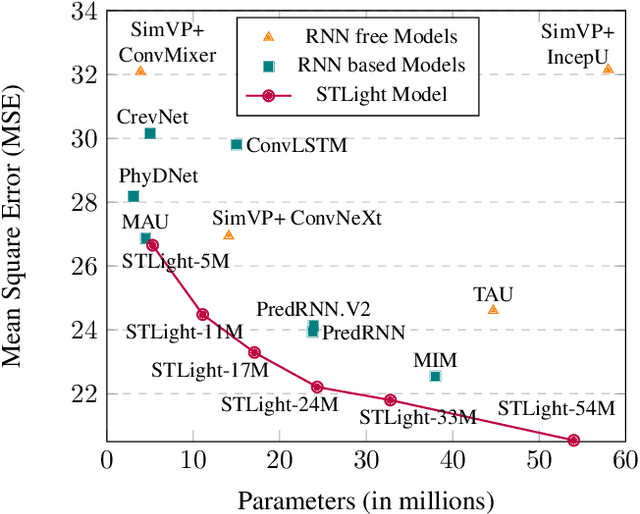



Abstract:Spatio-Temporal predictive Learning is a self-supervised learning paradigm that enables models to identify spatial and temporal patterns by predicting future frames based on past frames. Traditional methods, which use recurrent neural networks to capture temporal patterns, have proven their effectiveness but come with high system complexity and computational demand. Convolutions could offer a more efficient alternative but are limited by their characteristic of treating all previous frames equally, resulting in poor temporal characterization, and by their local receptive field, limiting the capacity to capture distant correlations among frames. In this paper, we propose STLight, a novel method for spatio-temporal learning that relies solely on channel-wise and depth-wise convolutions as learnable layers. STLight overcomes the limitations of traditional convolutional approaches by rearranging spatial and temporal dimensions together, using a single convolution to mix both types of features into a comprehensive spatio-temporal patch representation. This representation is then processed in a purely convolutional framework, capable of focusing simultaneously on the interaction among near and distant patches, and subsequently allowing for efficient reconstruction of the predicted frames. Our architecture achieves state-of-the-art performance on STL benchmarks across different datasets and settings, while significantly improving computational efficiency in terms of parameters and computational FLOPs. The code is publicly available
On the impact of key design aspects in simulated Hybrid Quantum Neural Networks for Earth Observation
Oct 11, 2024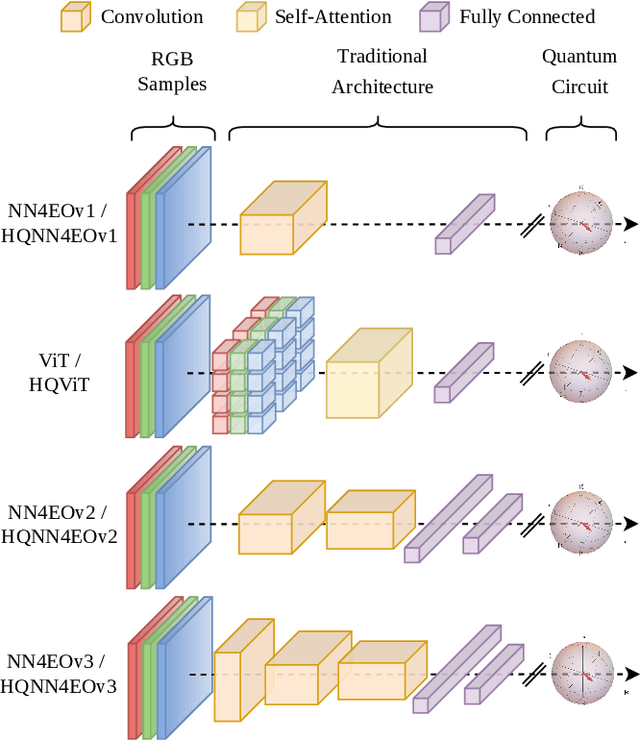

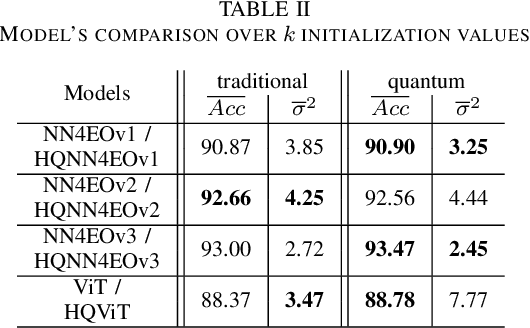

Abstract:Quantum computing has introduced novel perspectives for tackling and improving machine learning tasks. Moreover, the integration of quantum technologies together with well-known deep learning (DL) architectures has emerged as a potential research trend gaining attraction across various domains, such as Earth Observation (EO) and many other research fields. However, prior related works in EO literature have mainly focused on convolutional architectural advancements, leaving several essential topics unexplored. Consequently, this research investigates through three cases of study fundamental aspects of hybrid quantum machine models for EO tasks aiming to provide a solid groundwork for future research studies towards more adequate simulations and looking at the post-NISQ era. More in detail, we firstly (1) investigate how different quantum libraries behave when training hybrid quantum models, assessing their computational efficiency and effectiveness. Secondly, (2) we analyze the stability/sensitivity to initialization values (i.e., seed values) in both traditional model and quantum-enhanced counterparts. Finally, (3) we explore the benefits of hybrid quantum attention-based models in EO applications, examining how integrating quantum circuits into ViTs can improve model performance.
Deepfake Media Forensics: State of the Art and Challenges Ahead
Aug 01, 2024Abstract:AI-generated synthetic media, also called Deepfakes, have significantly influenced so many domains, from entertainment to cybersecurity. Generative Adversarial Networks (GANs) and Diffusion Models (DMs) are the main frameworks used to create Deepfakes, producing highly realistic yet fabricated content. While these technologies open up new creative possibilities, they also bring substantial ethical and security risks due to their potential misuse. The rise of such advanced media has led to the development of a cognitive bias known as Impostor Bias, where individuals doubt the authenticity of multimedia due to the awareness of AI's capabilities. As a result, Deepfake detection has become a vital area of research, focusing on identifying subtle inconsistencies and artifacts with machine learning techniques, especially Convolutional Neural Networks (CNNs). Research in forensic Deepfake technology encompasses five main areas: detection, attribution and recognition, passive authentication, detection in realistic scenarios, and active authentication. Each area tackles specific challenges, from tracing the origins of synthetic media and examining its inherent characteristics for authenticity. This paper reviews the primary algorithms that address these challenges, examining their advantages, limitations, and future prospects.
Continuous fake media detection: adapting deepfake detectors to new generative techniques
Jun 12, 2024Abstract:Generative techniques continue to evolve at an impressively high rate, driven by the hype about these technologies. This rapid advancement severely limits the application of deepfake detectors, which, despite numerous efforts by the scientific community, struggle to achieve sufficiently robust performance against the ever-changing content. To address these limitations, in this paper, we propose an analysis of two continuous learning techniques on a Short and a Long sequence of fake media. Both sequences include a complex and heterogeneous range of deepfakes generated from GANs, computer graphics techniques, and unknown sources. Our study shows that continual learning could be important in mitigating the need for generalizability. In fact, we show that, although with some limitations, continual learning methods help to maintain good performance across the entire training sequence. For these techniques to work in a sufficiently robust way, however, it is necessary that the tasks in the sequence share similarities. In fact, according to our experiments, the order and similarity of the tasks can affect the performance of the models over time. To address this problem, we show that it is possible to group tasks based on their similarity. This small measure allows for a significant improvement even in longer sequences. This result suggests that continual techniques can be combined with the most promising detection methods, allowing them to catch up with the latest generative techniques. In addition to this, we propose an overview of how this learning approach can be integrated into a deepfake detection pipeline for continuous integration and continuous deployment (CI/CD). This allows you to keep track of different funds, such as social networks, new generative tools, or third-party datasets, and through the integration of continuous learning, allows constant maintenance of the detectors.
Robust CLIP-Based Detector for Exposing Diffusion Model-Generated Images
Apr 19, 2024



Abstract:Diffusion models (DMs) have revolutionized image generation, producing high-quality images with applications spanning various fields. However, their ability to create hyper-realistic images poses significant challenges in distinguishing between real and synthetic content, raising concerns about digital authenticity and potential misuse in creating deepfakes. This work introduces a robust detection framework that integrates image and text features extracted by CLIP model with a Multilayer Perceptron (MLP) classifier. We propose a novel loss that can improve the detector's robustness and handle imbalanced datasets. Additionally, we flatten the loss landscape during the model training to improve the detector's generalization capabilities. The effectiveness of our method, which outperforms traditional detection techniques, is demonstrated through extensive experiments, underscoring its potential to set a new state-of-the-art approach in DM-generated image detection. The code is available at https://github.com/Purdue-M2/Robust_DM_Generated_Image_Detection.
 Add to Chrome
Add to Chrome Add to Firefox
Add to Firefox Add to Edge
Add to Edge